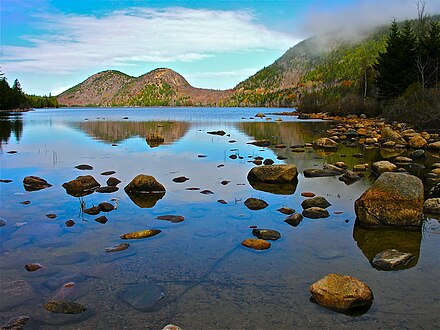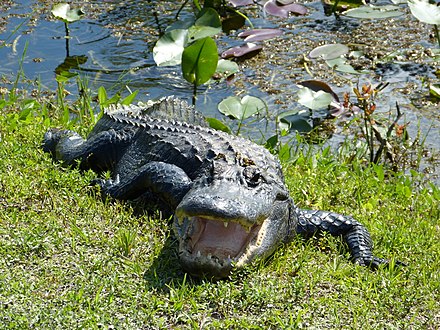United States national parks
United States national parks

Understand
If you're looking to see America in all its beauty, the national parks won't let you down. American national parks include some of the most spectacular natural scenery in the country, and they're often good places to go hiking in the United States and to see North American wildlife.
The geographical diversity of the national parks demonstrates that there is beautiful scenery to be appreciated across the country, and through the state parks system, visitors can find numerous additional destinations that rival the scenery of the national parks. The assumption that certain regions of the United States are spectacular, while others are boring, is at least partially a misrepresentation of the country's size and varied terrain.
New England
Maine
- Acadia National Park 📍 — Preserves a set of coastal islands with granite peaks, scenic shorelines, woodlands, and lakes.
South
- Great Smoky Mountains National Park 📍 (in two states, North Carolina and Tennessee) — A stretch of foggy Appalachian Mountains with a diverse population of wildlife and plant life.
Arkansas
- Hot Springs National Park 📍 — Situated in an urban area around a set of natural hot springs and historic bathhouses.

Kentucky
- Mammoth Cave National Park 📍 — The world's longest known cave system, with spectacular underground sights and wildlife.
South Carolina
- Congaree National Park 📍 — Preserves a section of old-growth floodplain forest. Is a UNESCO biosphere reserve and provides ample opportunities for birdwatchers, hikers, and other outdoorspeople.
Virginia
- Shenandoah National Park 📍 — Contains the Blue Ridge Mountains, with its scenic forests and the cataracts of the Shenandoah River.
West Virginia
Florida
- Biscayne National Park 📍 — Preserves the Biscayne Bay, with its abundance of marine wildlife.
- Dry Tortugas National Park 📍 — A set of islands at the end of the Florida Keys, home to Fort Jefferson, a Civil War-era fort that is the largest masonry structure in the Western Hemisphere.
- Everglades National Park 📍 — A vast wilderness of wetlands that are home to a diverse population of migratory birds, alligators, crocodiles, and manatees.
Midwest
Indiana
- Indiana Dunes National Park 📍 — Contains vast sand dunes and beaches, plants and animals, all within an accessible distance of Chicago.
Michigan
- Isle Royale National Park 📍 — Preserves a scenic wilderness on the largest island in Lake Superior.
Minnesota
- Voyageurs National Park 📍 — Protects scenic lakes, islands, and tall bluffs that were once populated by French fur traders.
Missouri
- Gateway Arch National Park 📍, St. Louis — On the banks of the Mississippi River in Downtown St. Louis, this park commemorates the Louisiana Purchase and the westward expansion of America. The centerpiece of the park is the massive Gateway Arch, the world's tallest arch and an icon of St. Louis.
Ohio
- Cuyahoga Valley National Park 📍 — Waterfalls, hills, and woods along the Cuyahoga River, as well as a section of the historic Ohio and Erie Canal.
Texas
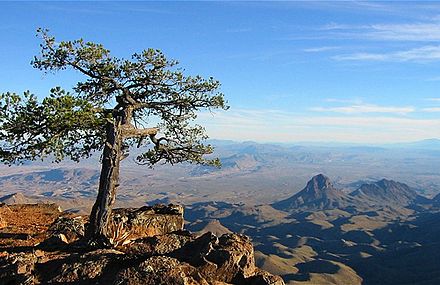
- Big Bend National Park 📍 — A bend in the Rio Grande along the U.S./Mexican border with spectacular desert scenery.
- Guadalupe Mountains National Park 📍 — A range of scenic desert mountains that make up the highest peaks in Texas.
Great Plains
North Dakota
- Theodore Roosevelt National Park 📍 — An area of Dakota badlands home to historic sites affiliated with Theodore Roosevelt and wildlife such as bison, bighorn sheep, and wild horses.
South Dakota
- Badlands National Park 📍 — Preserves an area of badlands and grass prairies to the east of the Black Hills, with rock formations famed for their rich fossil beds. The badlands include canyons made of rock similar in color to that of the Grand Canyon.
- Wind Cave National Park 📍 — The world's densest cave system, noted for its distinct calcite formations.
Rocky Mountains
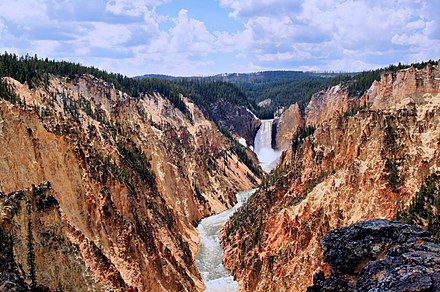
- Yellowstone National Park 📍 (Idaho, Montana, Wyoming) — The world's oldest National Park, famous for its geothermal features such as hot springs, boiling mud, and dramatic geysers, including the famed "Old Faithful". Also in Yellowstone is the yellow-cliffed Grand Canyon of the Yellowstone and its spectacular waterfall, mountain scenery, and some of the best wildlife viewing in the country, with bison, elk, gray wolf, and grizzly bears making their home here.
Colorado
- Black Canyon of the Gunnison National Park 📍 — An extremely deep and narrow canyon popular with river rafters and rock climbers.
- Great Sand Dunes National Park and Preserve 📍 — Preserves the tallest sand dunes in North America, situated at the foot of a tall mountain range.
- Mesa Verde National Park 📍 — Preserves a set of spectacular cliff dwellings that were home to the Ancestral Puebloan people, including the famed Cliff Palace.
- Rocky Mountain National Park 📍 — A scenic section of the Rocky Mountains home to picturesque lakes, alpine forests, and wildlife such as mule deer, black bears, and bighorn sheep.
Montana
- Glacier National Park 📍 — Numerous lakes and glaciers against a backdrop of spectacular Rocky Mountain peaks.
Wyoming

- Grand Teton National Park 📍 — Contains the iconic Teton Range, with its spectacular mountain peaks that rise dramatically from the valley floor.
Southwest
Arizona
- Grand Canyon National Park 📍 — The most famous canyon in the world, a vast wonderland of colorful cliffs and mesas carved by the mighty Colorado River. The canyon is thousands of feet deep and can be viewed from both the northern and southern sides; however, the side of the canyon that is visited the most is the southern side.
- Petrified Forest National Park 📍 — Famed for its collection of petrified logs, situated in a red rock desert with numerous dinosaur fossils and Native American sites.
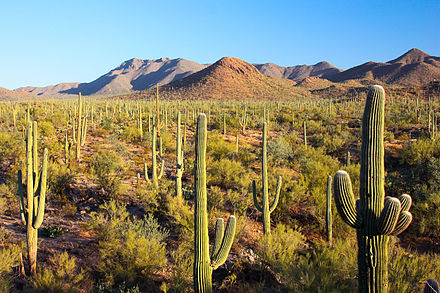
- Saguaro National Park 📍 — Protects a mountainous stretch of the Sonoran Desert famed for its abundance of tall saguaro cacti.
Nevada
- Great Basin National Park 📍 — Mountainous and desert landscapes home to bristlecone pines, this park is the home of the 13,000-foot Wheeler Peak and Lehman Caves. It's one of the quieter National Parks, being many miles from any towns or cities.
New Mexico
- Carlsbad Caverns National Park 📍 — Spectacular subterranean caverns with numerous stunning features and a large bat population.
- White Sands National Park 📍 — World's largest gypsum sand dune field— of fine white sand
Utah
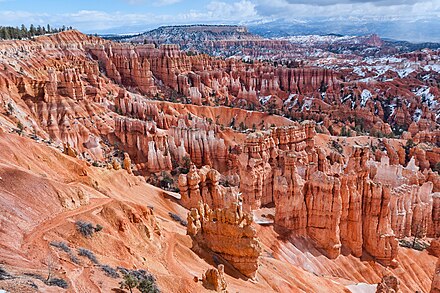
- Arches National Park 📍 — Contains hundreds of sandstone arches, including the famous Delicate Arch, an icon of Utah. Like the nearby Canyonlands, it's one of the more popular National Parks, despite being a long way from major cities.
- Bryce Canyon National Park 📍 — A geological amphitheater with hundreds of tall red rock hoodoos that make up a spectacular landscape in the midst of a pine forest.
- Canyonlands National Park 📍 — A maze of dramatic red rock canyons and mesas carved by the Colorado and Green Rivers. It is the meeting point of these two rivers, and therefore some excellent views of the canyons are possible.
- Capitol Reef National Park 📍 — A wonderland of red rock features including monoliths, arches, gorges, and sandstone domes.
- Zion National Park 📍 — Contains the spectacular Zion Canyon, with its sheer sandstone cliffs and dramatic rock towers, as well as beautiful red rock desert country.
California
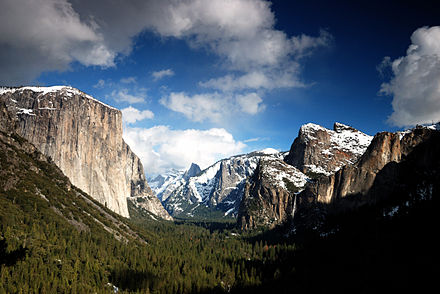 Dominant themes in the national park system in California are mountain ranges and deserts. As a result some are off the beaten path for a state that is a tourist attraction, although highways have been designed to improve access even to more remote areas. For example the highway system surrounding Yosemite connects it to the more populated Central Valley; the Yosemite Valley itself has been developed for tourism. The offshore Channel Islands have remained remote, as have the Pinnacles, while Death Valley is a popular destination despite its distance from cities. Deserts, mountains and redwood forests can be found on a generally smaller scale in the California state parks.
Dominant themes in the national park system in California are mountain ranges and deserts. As a result some are off the beaten path for a state that is a tourist attraction, although highways have been designed to improve access even to more remote areas. For example the highway system surrounding Yosemite connects it to the more populated Central Valley; the Yosemite Valley itself has been developed for tourism. The offshore Channel Islands have remained remote, as have the Pinnacles, while Death Valley is a popular destination despite its distance from cities. Deserts, mountains and redwood forests can be found on a generally smaller scale in the California state parks.
- Channel Islands National Park 📍 — A set of islands off the southern Californian coast with a diverse population of wildlife.
- Death Valley National Park 📍 — The lowest and hottest point in the country, Death Valley is a desolate landscape of sand dunes, canyons, and badlands straddling the California/Nevada border. Badwater Basin is the location of salt flats that are nearly below sea level; in the northern part of the valley is Scotty's Castle, where guided tours are available.
- Joshua Tree National Park 📍 — A desert landscape noted for its stands of distinctive tall yuccas, known as Joshua trees.
- Lassen Volcanic National Park 📍 — A set of active volcanoes including Lassen Peak, one of the largest domed volcanoes in the world. Lassen is part of the Cascades Range, a region of the United States with many large, well-known volcanoes including Mount Rainier, Mount Saint Helens, and Mount Shasta.
- Pinnacles National Park 📍 — Protects a set of jagged volcanic peaks and talus caves inland from the coast but west of the Central Valley; was previously a national monument.
- Redwood National Park 📍 — Protects the famed coastal redwoods, the tallest trees on Earth.
- Sequoia and Kings Canyon National Parks 📍 with Giant Sequoia National Monument (USFS) — Sequoia is famed for its forest of sequoias, including General Sherman, the world's largest tree. Adjacent Kings Canyon National Park protects a spectacular granite canyon and another sequoia grove.
- Yosemite National Park 📍 — One of the earliest national parks, famed for its towering granite cliffs, spectacular waterfalls, and rich old-growth forests. The park is centered around the dramatic Yosemite Valley, the setting for North America's tallest waterfall and the famous Half Dome and El Capitan peaks.
Pacific Northwest

Oregon
- Crater Lake National Park 📍 — Crater Lake, a lake famed for its clarity, is the deepest lake in the United States. It's in a spectacular volcanic caldera.
Washington
- Mount Rainier National Park 📍 — A volcanic peak and the most prominent peak in the Cascades, as well as glaciers and alpine forests.
- North Cascades National Park 📍 — Spectacular mountains and valleys carved by glaciers.
- Olympic National Park 📍 — Preserves a section of the Olympic peninsula, with temperate rainforests, alpine slopes, and the scenic Mount Olympus.
Alaska
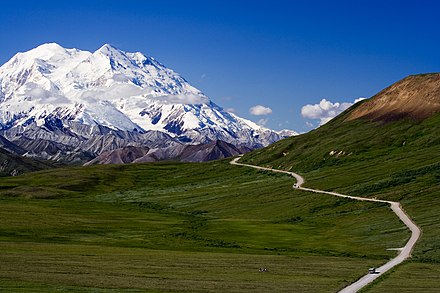
- Denali National Park and Preserve 📍 — Protects the area surrounding North America's tallest mountain; the mountain was previously called Mount McKinley.
- Gates of the Arctic National Park and Preserve 📍 — The northernmost of the National Parks, protecting an expanse of mountainous wilderness in the Arctic Circle.
- Glacier Bay National Park and Preserve 📍 — A coastal inlet with numerous glaciers, fjords, spectacular mountains, as well as large populations of wildlife like grizzly bears, mountain goats, killer whales, and seals.
- Katmai National Park and Preserve 📍 — Famed for its bear population, which congregates to catch spawning salmon.
- Kenai Fjords National Park 📍 — Protects the Harding Icefield, with its many glaciers and fjords.
- Kobuk Valley National Park 📍 — Known for the largest sand dunes in the Arctic and huge caribou migrations.
- Lake Clark National Park and Preserve 📍 — Active volcanoes, salmon-bearing rivers, glaciers, and waterfalls surrounding picturesque Lake Clark.
- Wrangell-St. Elias National Park and Preserve 📍 — Some of the continent's tallest mountains, numerous glaciers, and a icefield are among the attractions in this vast park.
Hawaii

- Haleakala National Park 📍 — Preserves an extinct volcano and the surrounding landscape.
- Hawaii Volcanoes National Park 📍 — Contains Kīlauea and Mauna Loa, two of the world's most active volcanoes. Tropical forests, barren lava beds, unique volcanic features, and active lava flows are all visible here.
American Samoa
- National Park of American Samoa 📍 — Covers land on three Samoan islands and protects coral reefs, rainforests, white sand beaches, and an abundance of sealife.
U.S. Virgin Islands
- Virgin Islands National Park 📍 with Virgin Islands Coral Reef National Monument — Pristine beaches, coral reefs, and forests, along with historical sites such as the ruins of sugar plantations.
See also
Related: United States of America
Related: United States National Parks
Related: Canadian National Parks
Related: National Trails System
Related: North America itineraries
